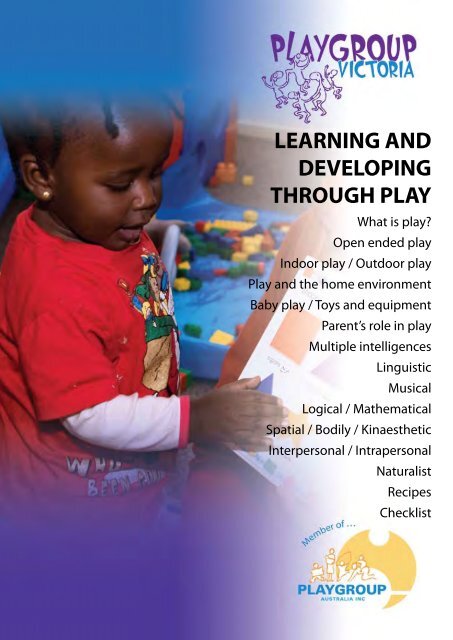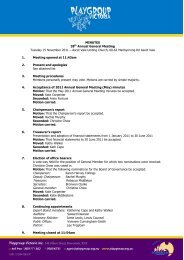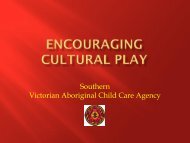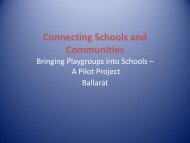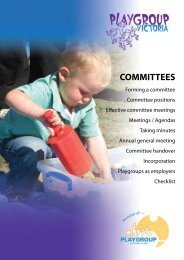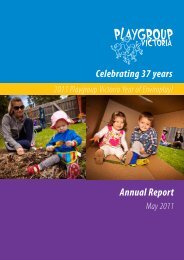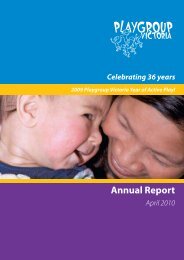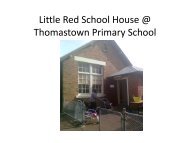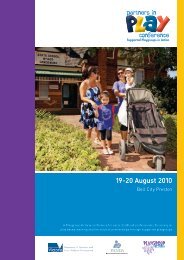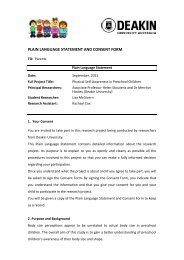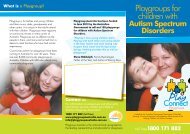All About Playgroup - Playgroup Victoria
All About Playgroup - Playgroup Victoria
All About Playgroup - Playgroup Victoria
- No tags were found...
You also want an ePaper? Increase the reach of your titles
YUMPU automatically turns print PDFs into web optimized ePapers that Google loves.
LEARNING ANDDEVELOPINGTHROUGH PLAYWhat is play?Open ended playIndoor play / Outdoor playPlay and the home environmentBaby play / Toys and equipmentParent’s role in playMultiple intelligencesLinguisticMusicalLogical / MathematicalSpatial / Bodily / KinaestheticInterpersonal / IntrapersonalNaturalistRecipesChecklist
LEARNING AND DEVELOPING THROUGHPLAYWhat is play?Play definitionPlay is an essential part of every child’s life and vital tothe processes of human development. It provides themechanism for children to explore the world aroundthem and the medium through which skills aredeveloped and practised. It is essential for physical,emotional and spiritual growth, intellectual andeducational development, and acquiring social andbehavioural skills.Play is a generic term for a variety of activities whichare satisfying to the child, creative for the child andmay be freely chosen by the child. The activities mayinvolve equipment or they may not, be boisterous andenergetic or quiet and contemplative, be done withother people or on ones own, have an end product ornot, be light hearted or very serious.Every child needs to play and has a right to play, butopportunities to play are often limited by externalfactors – discrimination, the effects of disability andspecial needs, insufficient space and otherenvironmental factors, and poverty and other socialconditions. Play services are the means by which newopportunities for play are created.National Voluntary Council for Children’s PlayPlay based learningPlay is a processYoung children are at the stage of development wherethey learn by doing. It’s the doing that matters to achild and contributes to his or her learning. It is notthe product to take home that is important. Forexample playing in the sandpit may involve feelingdifferent textures, mixing water to make sand sticktogether. As children sift, dig, pour and carry they learnhow to use their bodies. Both fine and gross motorskills are being used.Decorating a sand castle with a collage of shells,stones, leaves, flowers and gumnuts, children learnabout different concepts such as problem solving,counting, putting things in order and sorting.discrimination on the grounds of disability, culture,special needs, poverty, gender, social or environmentalrestraints.Play needs spacePlay spaces that facilitate learning and skilldevelopment are safe, offer opportunities for creativity,are age and stage appropriate, and are appealing andwelcoming to the child. Give children freedom to movein an area that is not overcrowded with other childrennor cluttered with toys and equipment.Play takes timeSet aside as much time as possible for play. This allowschildren to progress through stages of sensoryexploration, constructive and creative use of materials.Don’t rush children from activity to activity. Be flexiblewith your playgroup program.Play involves taking risksSmall children learn by imitating their peers or olderchildren. Each new skill is gained by trying somethingnew and taking a risk. Keep a balance between safetyand risk taking at playgroup.What play is based on for each childInterestObserve your child at playgroup and see whichactivities they most frequently enjoy. Be sure yourchild’s interests are met. Repeat their favourite activityoften to help them extend their concentration,knowledge and skills.Free choiceLet children play independently to choose what theyprefer to do, challenge themselves and be creative. Atplaygroup the role of the adult is to provide a range ofplay experiences, then support the child’s choice bybeing nearby, offering practical and verbal help ifneeded.Self-determination<strong>All</strong>ow each child to set the direction and pace of theirown play with minimal adult guidance or assistance.PreferenceWhen play is done for its own sake it builds selfesteem and is satisfying, pleasurable and good fun.Play is for everyoneIt is the right of each child to have an equalopportunity to join in play at playgroup free from30 <strong>Playgroup</strong> Manual
LEARNING AND DEVELOPING THROUGHPLAYOpen ended playOpen ended, free or unstructured play has no:• predetermined result• pressure to finish or complete something to anadult standard• model to copy• steps to follow.Children are free to think creatively and getsatisfaction from doing things their own way and usingtheir own ideas. They decide how to start, whatdirection to take, how to solve problems along the wayand when they are finished.Open-ended play is about exploring, experimenting,discovering and creating.Play in itself is not specifically goal orientated. If adultsconcentrate on teaching and aim for an end product,play is robbed of its life and freedom.Adults can help by providing lots of opportunities anduninterrupted time for this type of play.At playgroup open-ended play materials include: paint,playdough, clay, blocks, construction sets, balls, homecorner, dress-ups, wheeled toys, boxes, sand and waterplay.Open-ended art and craft activities give children theopportunity to explore and experiment with themediums of their own choice. They can be imaginativeand innovative and create a unique piece of work andsay, “I did it all by myself”.Develop creativelyYou don’t have to come up with new craft ideas everyweek at playgroup. Children love repetition. Theyacquire and develop skills through continual practice.Adults help maintain interest in open-ended activitiesby making slight variations such as setting up indifferent ways, sometimes inside, sometimes outside.Set up on a table top, on the floor or on a blanket undera tree.Change colour, recipes, shapes and textures to createnew interest. Mix and match activities like making atunnel from a large box to push or ride wheeled toysthrough. Add a different piece of play equipment likesome bats to the balls or teapots to the home corner.Develop the mindUsing an open ended approach helps develop aninquiring mind that is able to solve problems andnegotiate with others. Ask open ended questions thatare thought provoking and can’t be answered with ayes or no such as, “What would happen if…?”, “How doyou think you can fix this?”, “How do the clouds stayin the sky?”, “Which one do you like better?”, or “Whyis that?”Accept answers without judgement. This encouragesthe child to share their thoughts, ideas and opinionswithout fear of judgement and being wrong.This type of question and response:• focuses on what the child is doing• encourages children to think and respond• values their opinions and ideas• develops language skills• develops imagination and a sense of wonder• develops sequential thinking and problem solvingskills.Setting up open ended playWhile open ended play is spontaneous it takes carefulthought and planning to be effective. To encourageopen ended play:• observe children to know their interests andabilities• put out appropriate open ended play equipmentthat invites children to play• give freedom to children to choose and set thedirection of their own play• be flexible with the program to allow childrentime to develop their play• be available with ideas and resources that willextend the play.Childhood has its own way of seeing, thinking andfeeling, and nothing is more foolish than to try tosubstitute ours for theirs.Jean-Jacques Rousseau, Emile<strong>Playgroup</strong> Manual 31
LEARNING AND DEVELOPING THROUGHPLAYIndoor playSetting the sceneSetting up your playgroup room requires specialconsideration as babies and young children are atdifferent ages and stages of development. <strong>All</strong> childrenneed to be able to freely move around a play room andconfidently play in a hazard and danger freeenvironment.Ask parents to dress their children for play;inappropriate clothing may limit their ability to befully involved in the play.Carefully setting up will affect how children play andcan help minimise accidents and conflict.The playgroup environment will need to be attractiveand interesting to children, with plenty ofopportunities for them to explore, experiment, developtheir ideas and be creative.As each child finishes an activity the supervising adultwill need to be ready to reorganise the space to make itready for the next child.Things to set up• Simple experiences at children's level• Several open ended play experiences such asdough, clay, painting, collage, drawing andpretend play• Opportunities for children to experiment, exploreand use situations and materials their own way• Ample materials, play spaces and choices for eachchild e.g. if there are four chairs at a playdoughtable, you will need four lumps of dough, fourrolling pins and four sets of cutters• A special, safe, play space on the floor for babies• Chairs or cushions on the floor for adults to sit onwhen they supervise or play with children• Furniture or partitions so there are no longcorridors that invite running indoors• Separated, defined play areas where possible• Play that creates a mess in an area that can beeasily washed down or on a large tarpaulin spreadout to protect the floor. Have smocks, hand towelsand water available• Busy and quiet areas where children can playalone or in groupsThings to avoid• Tricycles or similar equipment indoors which maydisrupt other children’s play or harm smallchildren• Clutter caused by too many toys and choices thatover-stimulate or confuse children• Insufficient materials, sharing and waiting breaksthe flow of play can lead to frustration anddisinterest• Background music that increases noise levels andcan distract and overstimulate children• Play that requires hours of preparation or tiringclean up for adultsOther considerations• Involve children in choosing and setting upactivities.• Plan activities for fun and pleasure.• <strong>All</strong>ow uninterrupted time for play.• Include all children irrespective of age or abilities.• Develop each child's interests.• Cater for each child's developmental stage.• Supervise children for safety and fair play.• Be culturally relevant to all families in yourplaygroup.• Treat boys and girls equally.• Discourage competition.• Encourage exploration and experimentation.• Have reasonable expectations about tidiness andmess.• Plan simple, enjoyable sessions.Things to include for adults• Time to play with their child• Time for adult socialising and conversation• Opportunities to share and contribute• Times to discuss and make decisions about theplay program32 <strong>Playgroup</strong> Manual
LEARNING AND DEVELOPING THROUGHPLAYOutdoor playNatural play spaces give children theopportunity to experience seasonal changes,to feel, touch, smell, hear natural elementsand interact with them. Help children toappreciate and take responsibility for theirnatural environment.Most, if not all play can be either indoors or outdoors.Traditional indoor play activities like puzzles,playdough or drawing can be enjoyed outdoors andwith a little planning sand, water and ball play can befun indoors.When creating outdoor play spaces for children atplaygroup the principles are similar to ‘Indoor play’ onthe previous page. Also consider:• playground safety and security• being dressed for the weather• individual interests and abilities• giving children freedom to create their own playwith sand, water, cubbies, balls, wheeled toys,large cardboard boxes• opportunities for physical exercises like running,climbing, lifting, carrying, balancing.Establishing an outdoor play areaSpaces for playPlanning effective and efficient outdoor play spacesadds to the quality and variety of outdoor play. Setspaces that provide for:• challenging activities such as balancing, climbing,tunnelling, swinging• running, ball games, chasing bubbles, pushing orpulling, spinning or riding wheeled toys• sensory play with sand, mud, water, pebbles,stones, plants and flowers• hiding away, high observation places, cubby housebuilding, picnic places• meandering, observing, watching a snail, ants or abutterfly• a small bench for being alone or with a friend• meeting as a group for songs or a story• pretend work such as building dams, washingclothes, building roads• imaginative play with dolls, jungle animals,insects, blocks.SafetySee ‘Hunt for hazards’ and ‘Control hazards’ on pages63 and 64. Ask the owners of your playgroup buildingsto remove any leftover building materials that may bein the play area, or arrange a working bee to keeplawns short. Clear away any rubbish that may attractsnakes, spiders or wasps.FencingEnclose the entire outdoor area with fencing thatchildren cannot climb over, go through or get under.Have a self-closing, self-locking, childproof gate.StorageSome outdoor equipment is large and may need to bestored in a shed. It is a good idea when installing acubby house or fort to include a storage areaunderneath for bikes, tricycles and wheeled toys.ShadeIf there are no naturally shaded areas, hang tarpaulinsor install shade cloth over areas where childrenfrequently play. See ‘SunSmart’ on page 73.Sheltered areaA pergola with a roof, attached to an outdoor wall,gives children a place to play outdoors even when it israining. It makes a great area for painting and otheractivities that make a mess.Fixed equipmentIf you choose to install fixed equipment such asswings, slides, forts, cubby houses or climbing bars,first check the Australian standards for playgroundequipment. Have the right soft fall material under eachpiece of equipment. See ‘Soft fall under surfacing’ onpage 69.Weigh up the benefits of installing fixed equipmentagainst the cost of buying smaller movable pieces thatcan be used both indoors and outdoors.Fixed equipment is often very expensive and seldomused. If your playground has fixed or unsuitableequipment change the way it is used by addingblankets, boxes, wooden cable reels or other attachableitems.SandpitPlaying in the sandpit is the most popular outdoorexperience at playgroup. Build a sandpit in a welldrainedposition that has sun and rain to sterilise the<strong>Playgroup</strong> Manual 33
sand. Cover the sand with shade cloth or other porousmaterial when not in use to prevent animals,particularly cats, fouling it.Natural areasRemove any poisonous or highly allergenic plants.Develop a garden by planting flowers or vegetables.Partition off a small area for a digging patch and addwater for mud play. Have a bird bath and observenature's visitors.Bike pathA safe, circular bike path or defined wheeled toy areawill prevent wheeled play interfering with otherchildren’s outdoor exploration.Be safe outdoors. See ‘Playground safety’ on page 69.Social playSome parents worry because their child doesn’t playwith other children. Play in a social context progressesas the child grows, develops and becomes familiar withroutines, expectations and the people around them.Some children learn by standing apart and watchingother children play. <strong>All</strong> children progress through thefollowing stages of playing:• alone, absorbed in what they are doing• alongside one another without interacting• together at the same activity but each playingtheir own way, with little organisation or groupgoals• cooperatively with other children in a morecomplex, organised way with common goals andrules and perhaps one or two children directingthe play.34 <strong>Playgroup</strong> Manual
LEARNING AND DEVELOPING THROUGHPLAYPlay and the homeenvironmentFrom birth, babies play and use all theirdeveloping senses to explore their new worldand they do most of this at home with family.<strong>Playgroup</strong> <strong>Victoria</strong> recognises and highly valuesparents as children’s first and most enduring educatorsand the crucial role the home environment plays inproviding early play experiences.There is a growing awareness that the importance ofunstructured free play experiences in early childhoodare linked to a child’s optimal physical, emotional,social and cognitive development.In the midst of this growing public awareness comes compellingnew scientific evidence about play – evidence that play “sculpts”the brain in unique ways – play not only promotes optimaldevelopment, but also builds resilience and reduces stress.Jane Hewes Early Childhood Chair, MacEwan College, Edmonton,CanadaThis section has been proved to help you enrich playtimes at playgroup and at home.Share the link to the member’s section onwww.playgroup.org.au or photocopy relevantinformation and hand it out at playgroup and talkabout it and how the ideas can benefits children atplaygroup and at home.• Encourage your child to repeat and practise newskills they learn at playgroup.• Take time to chat about what happened atplaygroup.• Ask thought provoking questions.• Reinforce at home what your child is learning atplaygroup about safety, healthy foods, healthychoices and being SunSmart.• Regularly make time to have fun playing as afamily. Read books, sing and dance to favouritemusic, tell stories, go on a train ride, visit thebeach, zoo or wildlife sanctuary.• Use travel time to sing playgroup songs, retellstories or play simple games like spot the taxi, bus,etc.In your communityFind out what’s happening in your local community.Visit your council’s website and look for children’s andfamily services or phone and ask. Join the local library,toy library or visit local parks and other places ofinterest. Look for information about local festivals inlocal papers or on community notice boards.For more information• Read the <strong>Playgroup</strong> <strong>Victoria</strong> member magazineTotline.• Subscribe to e<strong>Playgroup</strong> News atwww.playgroup.org.au.• Download A-Z playsheets from the member’ssection at www.playgroup.org.au.At playgroup• Watch what your child enjoys and include this intheir home play.• Buy gifts for your child to extend their favouriteplaygroup play experiences.• Observe which learning style your child prefersand build this into daily and family routines.At home• Set up a special play space at home indoors andoutdoors.• Rotate toys and equipment according to yourchild’s current interest.• Give your child plenty of time to play alone, withfriends and with the family.• Invite playgroup friends home to play<strong>Playgroup</strong> Manual 35
LEARNING AND DEVELOPING THROUGHPLAYBaby playFrom the time a baby is born everything hesees, touches and does arouses curiosity anda desire to learn.<strong>Playgroup</strong>s support this learning. Babies love beingpart of the busyness at playgroup and are oftenmesmerised watching and interacting with otherchildren. New babies are best left safely in a pram orheld by their parent.Older babies will busily examine everything aroundthem, learning by seeing, touching, tasting, feeling andhearing. They explore and experiment to discover newinformation. New skills are mastered through practiseand repetition.At playgroup, you can help by understanding the waybabies learn and providing a variety of playexperiences.Create a safe place for babies to play in your playgrouproom out of the main traffic flow. Put a large rug on thefloor or grass outside and add some baby toys.Popular baby toys• Soft blocks or balls• Rattles• Activity centres• Safety mirrors• Mobiles• Commercial or homemade baby mats• Prams, cots or ‘A’ frame baby gyms• Soft toys• Bead frames• Books• Containers or plastic ware• <strong>All</strong> these toys in a box, bag or basket for olderbabies to unpack and packQuiet playPlay is not always busy; it can be restful and soothing.Quiet reflective play is as important to your child’swellbeing as times of social and physically active play.Give babies time to lie on their backs to stretch, kickand develop hand skills or on their tummy tostrengthen back, neck, shoulder and arm muscles andto practice head control.If a baby becomes unsettled at playgroup the parentcan share a book, sing lullabies or take the baby towhere children are playing.MusicGather a few babies and parents together and sing orchant simple nursery rhymes like, Humpty Dumpty. Addfinger movements as you sing Twinkle, Twinkle, Little Star,or put actions to Row, Row, Row your Boat. Play gameslike Peek–a–Boo or touching games such as Round andRound the Garden. Play different styles of music. Putshakers, rattles and musical toys with the baby toys.Babies are active learnersTheir toy play develops through the following stages:• watching objects• following moving objects with their eyes• reaching out• taking hold of an object• examining it with eyes and hands• squeezing and patting with hands• passing the toy from hand to hand• putting it to their mouth to explore it by sucking,biting or chewing• dropping it to watch it fall• banging toys together.It is not necessary to buy expensive toys. Put togethera container of safe colourful objects from around thehome. You could even try making things for babies toplay with.SafetyWhen offering toys to a baby avoid:• anything sharp or broken• anything smaller than a film canister• detachable or small parts like buttons and eyes• cords longer than 30cm• toxic paints or plastics.36 <strong>Playgroup</strong> Manual
LEARNING AND DEVELOPING THROUGHPLAYToys and equipmentBasic toys and play equipment forplaygroups• A variety of balls, small bats• Interlocking or wooden blocks, construction sets(at least 20 large pieces)• Washable dolls, doll’s bed and bedding• Baby toys, rattles, soft toys, washable or cardboardbooks• Large crayons, paste and paint brushes, non spillpaint pots, blunt ended scissors,• Puzzles• Sets of animals, cars, trains, musical instruments,tea sets, cooking sets• Buckets, spades, scoops, dump trucks and gradersfor the sandpit or digging patch• Push or pedal wheeled toys such as tricycles,walker wagons, pull along toys, dolls' prams,wheelbarrows• Floor rugs, play mats• Tarpaulins or sheets of strong plastic to protectfloor from messy play activities• Storage boxes• Furniture for small childrenTen questions to ask when choosing toysfor playgroup1. Will it withstand constant, heavy use?2. Is it safe for all children or will it need to be usedin a restricted area?3. Can it be easily cleaned?4. Is it appropriate to the children's abilities?5. Does it encourage social interaction or is it usedindividually?6. Is it simple and able to be used by children ofdifferent ages?7. Does it give the opportunity to develop andpractise new skills?8. Does it have scope for imagination andexperimentation?9. Is it in line with the interests of this group ofchildren?10. What is its value – does it entertain, encouragephysical play, foster creativity or is it a tool forimaginative play?Take into account individual differences. The aptitude,personality and interests of a child will determinewhich toys he or she prefers. Toys that fascinate onechild may be of no interest to another.Recycled materials for play• Cartons and boxes become building blocks,cubbies, cars, boats, a doll’s bassinette, containersfor packing and emptying, tunnels for crawlingthrough, a surface for painting• Plastic drink containers can be used for filling andemptying with water or sand, shakers for music,cut down to make funnels and scoops• Ice-cream container lids can be used for stencils• Coloured lids can be sorted or threaded into ababy’s rattle• Tyres (not steel belted) can be stacked, rolled, cutin half for water or sand play, used as a swing or inan obstacle course• Paper off-cuts, old posters can be used for tearing,drawing, painting, cutting and pasting• Dresses, skirts, shirts, ties, waistcoats, cameras,bags, belts, scarves for dress ups for pretend androle play• Cardboard cylinders for telescopes or flutes.Find out moreReverse Art Truck at two locations, 17 GreenwoodAvenue, Ringwood, 9879 1264 and the rear of CaseyIndoor Leisure Complex, suite 15, 65 BerwickCranbourne Road Cranbourne, 5995 3168 or visitwww.reverse-art-truck.zoomshare.com.<strong>Playgroup</strong> Manual 37
LEARNING AND DEVELOPING THROUGHPLAYParent’s role in playParents and playChildren laugh as a dad plays rough and tumble withsome toddlers. A few parents exchange ideas over acup of coffee. A grandmother cuddles a baby as shepoints to the pictures in a book. A young mum pushesher child on a swing. These are common scenes atplaygroup.Closer observation will show that the role of adults inchildren's play falls into five distinct styles.1. PlannerThis adult observes the child at play anddetermines their interests and abilities. They planintentional play experiences to support andextend the child’s holistic development based onthe child’s preferences, values and abilities. Everyopportunity is taken to involve the child in theplanning process.2. DirectorThis adult organises the play and directs the child.They will take the child to the activity, show thechild how and what to do and stay close by tomonitor the child’s progress.3. FacilitatorThis adult centres their attention more on thechild than on the play. The child is encouraged tochoose the activity and play independently whilethe adult stands back without getting involved.The adult is an encouraging and supportiveresource person who attends to requests forassistance from the child.4. PartnerThis adult plays with the child as an equal.Sometimes the adult and sometimes the childinitiate and choose the play direction. The adultand child negotiate about ideas and leadership.The adult becomes a playmate in the real sense,neither dominating nor encouraging, but activelyjoining in the play.5. ObserverThis adult gives the child freedom to play alonewith little or no interaction. The adult allowstime and space for the child to play independently.Children create their own play opportunities andsocialise freely with other children and adults.A balanced mix of the five styles in a playgroupsession is ideal. Each style has its advantages anddisadvantages.Plan time for adults to chat and enjoy friendships.This is an important part of the playgroupexperience. <strong>Playgroup</strong>s are not just aboutchildren’s play.SupervisionMake sure when a family starts at your playgroup theyunderstand that they are responsible for supervisingeach child they bring. It is not the responsibility of thecoordinator or session leader. Supervision at playgroupis about duty of care, behaviour guidance, safety andfair play that is fun for everyone.Inappropriate behaviour that hurts other people ordisrupts another child’s play needs to be handled bythe parent or caregiver so that the child learns tointeract within acceptable limits.At the most basic level, supervision contributes toprotecting children from hazards, however adequatesupervision occurs when each child is being observedconstantly, actively and diligently by the adults in theplaygroup.As adults supervise they observe their child and learnhow their child plays and relates in a group setting. Bybeing on hand they are available to guide and supporttheir child’s play.Essentials of supervisionBe sure everyone understands that no baby, child orgroup of children may be left unsupervised in a car,room or outdoors.Children must be taken, not sent, to the bathroom.Potential danger areas such as the kitchen, storeroomor offices need barriers to keep children safe.When a parent or caregiver is on a rostered duty theyneed to make arrangements with another playgroupmember to supervise their child.Children who are in danger or in conflict need to beremoved from the situation by the nearest adult andtaken to their parent or caregiver.Adapt the level of supervision to the circumstance.When there is potential danger such as swings, waterplay, scissors or climbing equipment, the adult’s fullattention is necessary. Visual contact and being closeby may be adequate in the home corner or sandpit.38 <strong>Playgroup</strong> Manual
LEARNING AND DEVELOPING THROUGHPLAYMultiple IntelligencesA relatively new theory of learning suggests there aremultiple intelligences in different areas of the brain.Human beings have all the multiple intelligences, buteach person has their own unique combination. Thistheory broadens the perspective of a single intelligencethat is given a score according to an I.Q. test.Many schools now apply the multiple intelligencesconcepts in their classrooms. <strong>Playgroup</strong>s can alsobenefit by incorporating this theory to their planningand setting up for play.Multiple intelligences – a simpledefinition• Linguistic the intelligence of words• Musical the organisation of sounds and rhythms• Logical/mathematical exploring objects and whatthey do• Spatial pictures, patterns and images• Bodily/kinaesthetic the skilful use of our physicalbody• Interpersonal social relationships• Intrapersonal self knowledge• Naturalist learning from natureMost people display competencies in each of theintelligences but have greater strengths and talents intwo or three.For playgroup parents and caregivers workingtogether to make their play program valuable forbabies, toddlers and preschool children’s growth anddevelopment, the multiple intelligences theory helpswhen planning, choosing equipment and respectingeach child’s uniqueness.PlanningThe multiple intelligences theory simplifies planningplaygroup activities. It shows how children learn andgives a blueprint for the type of activities that nurtureeach child’s interests and innate love of learning.Consider all the multiple intelligences when you planyour play program and set up toys and equipment.When you put out activities to cover all theintelligences and allow children to be self-directedthey can both develop and apply their learning withintheir preferred method and have a chance to trydifferent ways of learning.Choosing equipmentGetting together playgroup toys and equipment issimplified because there is a checklist to ensure you areproviding a balance of experiences. Try to have at leastone playgroup activity for each intelligence. Many playexperiences incorporate several intelligences and somecover all the intelligences.Respecting each child’s uniquenessKnowing the multiple intelligences means you can bemore understanding of children’s preferences in play.You are more relaxed if some children want to beoutside most of their time while others want toexplore or create indoors. You have greaterunderstanding of a child who wants to be alone whileothers prefer to play in groups.On the following pages there are some basic activitiesthat nurture each intelligence, keeping in mind thatthe multiple intelligences interweave in complex waysand that children bring to all the intelligences their funloving playfulness, unique personality, avid curiosity,vivid imagination, endless creativity, exceptionalwisdom, inventiveness and vitality.Here is a P-L-A-Y-G-R-O-U-P acrostic you can easilyapply to check that all the intelligences are beingcovered and you are catering for each child’s individuallearning preferences.Ask yourself. Did my child….P – have plenty of physical activitiesL – use and hear languageA – have time to explore, analyse, think and reasonY – have space to be alone, by yourselfG – have group time with one, two or more friendsR – enjoy rhythms and musicOU – spend time outdoors exploring nature or bringnature indoorsP – picture and imagine then create or construct?Above all, was playgroup fun?If the answers are “Yes” you can be assured that yourplaygroup is providing plenty of opportunities forlearning through play.<strong>Playgroup</strong> Manual 39
LEARNING AND DEVELOPING THROUGHPLAYLinguisticLinguistic intelligence is being able to usewords effectively.At playgroup create an environment that is vibrant inwords and language.Encourage conversations, negotiations anddiscussions. Ask questions and introduce newvocabulary.Chat together about playgroup routines, talk aboutwhat’s happening and what is about to happen. Recallevents and talk about the sequence in which thingshappen.Read books, sing songs, enjoy poetry, tell stories orchant rhymes.Developmental importanceLinguistic activities encourage children to:• express thoughts, ideas and emotions• learn that pictures tell stories• learn to concentrate, remember and understandnew words and ideas• develop an appreciation of books• increase attention and concentration• build confidence to participate and communicate• develop the ability to express their own ideas• develop the ability to discuss, negotiate and beassertive• develop new interests• express feelings through verbal and non-verbalcommunications• add new words to their vocabulary• understand that their thoughts, ideas and storiescan be expressed in pictures, words and symbols• increase verbal communications• use information from books• gain confidence to ask questions• appreciate language and stories from differentcultures• play with nonsense words and rhymes• begin to use the intonations of their language• explore patterns and rhythms of words andlanguage.Basic equipmentStory books, picture books, nursery rhyme books, songcards, laminated pictures, photo albums, playgroupmade books, charts, story book CDs, CD player,sequence cards, story cards, puppets, phones, mail box,letters, paper crayons, simple board or card games forolder children, sets of toys that encourage cooperativeplay i.e. dolls houses, train sets with floor mat, cubbyhouses, water play troughs, floor puzzles, role playsets, group paintings, collage, felt boards and pictures,sound puzzles/books, microphonePopular linguistic activities• Set up a comfortable library space with engagingbooks that are easily accessible to children.• Read stories and converse using languages thatmay be spoken by families in the playgroup.• Read and tell stories.• Use words in songs, rhymes and chants.• Explain new words.• Make up stories as children play. Encourage themto make up their own stories.• Have plenty of picture books.• Laminate some pictures of particular interest andtalk about them with the children.• Use verbal and non-verbal communication.• Read traditional and cultural stories appropriateto playgroup families.• Enjoy nonsense rhymes and made up words.• Use finger and hand puppets to encourageconversations.• Role play talking on the phone.• Play post office, scribble letters, put them inenvelopes and mail them.• Go on an excursion; follow up by making a photoalbum with captions and children’s names.• Make a poster about each child with photos andshort captions about their interests.• Chat as a child plays.• Ask open-ended questions.40 <strong>Playgroup</strong> Manual
LEARNING AND DEVELOPING THROUGHPLAYMusicalMusical intelligence is the reaction to andmanipulation of rhythm, timbre and tone ofmusical sounds.<strong>All</strong> children, even tiny babies, respond to music. Atplaygroup music can be introduced spontaneously oreveryone can get together for a group music session.Developmental importanceMusical activities encourage children to:• acquire a love of music• learn the basic elements of music: fast and slow,loud and soft, high and low• experiment with sounds and melodies• develop listening skills• express emotions, follow directions and cooperate• improve language, speech and memory• enjoy an energetic time of dancing, marching orfreely moving to music, exploring space• gain confidence and body awareness• have enriched story times and imaginative play• develop creativity through expressive movementor making up their own songs• learn about and use musical instruments• build a repertoire of songs.Music can be used to set the mood of your playgroupsession – lively music to brighten everybody up, gentlemusic to calm them down. Expose children to differentstyles of music particularly relevant to your playgroupfamilies. You don't need to be musically talented toshare and enjoy music at playgroup. Spontaneouslystart singing to the children and forget yourinhibitions.Try a group music session. They work best if allparents and caregivers join in and babies are included.<strong>All</strong>ow children to join in as they are ready. Some willprefer to stand back and observe for a few weeks.Basic music equipmentMake up a music kit for your playgroup. Have bothgood quality and home made instruments: maracas,castanets, drums, bells, shakers, tambourines, rhythmsticks, xylophones, cymbals, rain sticks and blocks.Avoid blowing instruments at playgroup because ofthe risk of cross infection.Add streamers, scarves, floating material, dress ups,tutus or leis for dancing. Include a toy microphone,puppets, soft toys, song cards, parachute, a variety ofrecorded music, wind chimes and commercial musicalbaby toys.Popular musical activitiesSinging• Sing songs with actions, finger play, clapping orsongs that include the children’s names, circlesongs or games.• Make a CD compilation tape or song cards of thegroup's favourite songs and rhyme.• Gather together for a farewell song.• Use finger puppets or hand puppets to sing alongor introduce a song.• Play parachute games to music or singing.Dancing to music• Move in time to music: dance, clap, march, jump,stamp feet, nod the head.• Wave streamers, scarves or pieces of floatingmaterial to different styles of music.• Dress up, put on some face paint or adhesivecoloured stars and sing or dance to the beat.• On special occasions play music to set anatmosphere for children as they blow bubbles,manipulate playdough, draw with crayons orfinger paint.• Play gentle music and ask children to lie down andrelax.Listening• Draw children’s attention to the musical soundsand rhythms around them: of a phone ringing,birds singing, car horn blowing.• Put out musical toys, mobiles and wind chimes.• Attend a children’s concert.Instruments• Make musical instruments like a simple shaker,tambourine, rhythm sticks or drum.• Play music or sing songs with a definite beat andlet them play along.• Add variety by encouraging the children to maketheir shakers go fast and slow or loud and soft.<strong>Playgroup</strong> Manual 41
LEARNING AND DEVELOPING THROUGHPLAYLogical/MathematicalLogical/mathematical intelligence is aboutconcepts, numbers and logical thinking.Babies and toddlers explore their world with thecuriosity of a scientist. They observe, touch, taste,smell and listen to test the properties of any object inreach.Concepts are formed as they arrange and rearrange,predict, classify, group things into sets, discoversequences, make patterns and solve problems.Through play children discover cause and effect andhow objects behave under certain circumstances. Theylearn that objects exist even when out of sight.As they gain language skills they express theseconcepts in words like ‘more’ or ‘less’, ‘empty’ or ‘full’.Counting becomes a game that can be reinforcedthrough songs and rhymes.Through pretend play, sometimes referred to assymbolic play, children learn that a symbol canrepresent or resemble an object e.g. two candles or thenumber two on a birthday cake or card representsbeing two years old.Developmental importanceLogical/mathematical activities encourage children to:• be innovative and curious• learn the relationship between cause and effect• explore and experiment though their five senses• acquire knowledge by figuring it out forthemselves• develop a love of learning through discovery• learn about how objects behave under differentcircumstances• develop concepts about their environment• solve their own problems creatively• think logically• be confident to predict and estimate• recognise, compare, sort and classify shapes andobjects• put objects in sets and match one-to-one• create and use symbols• have a positive self-esteem through satisfactionand achievement• develop number concepts and understandcounting.Basic equipment• Soft or wooden blocks with cube and other shapes• Bead frames, peg boards, stacking rings, threading,posting or sorting boxes• Jack-in-the box, simple matching games,construction toys, train sets with interlockingtracks• Sets of cars, trucks, farm animals, zoo animals,dinosaurs, sea creatures, soft toys or people• Birthday cake with candles• Picture dominoes, simple lotto games• Clocks, phone or cash register, balance scales• Different sized containers for water play, bucketsfor sand play, shapes for playdough• Cardboard boxes• Tea sets and sturdy plastic cutlery sets, magneticfishing game• Basic electronic toys• Balls and bean bags• Basic wooden puzzles or floor puzzles for shaperecognition, arranging smallest to largest,counting, sequences, sorting, matching,measuring, classifying and logical thinkingPopular logical/mathematical activities• Thread and create patterns with cotton reels, largebeads or buttons• Sort, pile, stack, order, count and knock downblocks or boxes• Cut, stick, glue, assemble, build and constructwith collage• Design, rearrange, make choices and produceoutcomes with sets of small toys• Build with construction toys• Explore, manipulate and discover cause and effectwith a variety of toys• Rearrange soft wooden or floor puzzles• Play simple board or card games• Discover the properties of water: full/empty,floating/sinking, wet/dry• Discover the volume/shape of playdough• Discover heavy/light, full/empty, concepts such ason, under, in sand play42 <strong>Playgroup</strong> Manual
LEARNING AND DEVELOPING THROUGHPLAYSpatialThis intelligence is picture orientated. It isabout shapes and forms and being able toperceive and recreate aspects of the visualworld accurately or abstractly.When children paint, draw, design and construct twoand three dimensional works of art, it is important togive them time to think about what they are going tocreate as they begin. Do not expect them to startstraight away, give them time to decide for themselves.Making children copy preplanned models by adultsdoes not encourage creativity and is likely to stiflechildren’s ideas.Create familiar spaces at playgroup by putting outsimilar play experiences each week in the same place.This will help children to visualise how their body fitsinto these spaces and give them confidence in beingable to find pathways independently to and from theirfavourite spaces.Imaginative and fantasy play builds a child’s capacityto think in images and pictures.Puzzles, blocks and construction toys help withdistinguishing form and shapes.Play with colours using paints, crayons, collage, light,shade, mirrors and shadows.Playing outdoors and going on excursions giveschildren the opportunity to gain both long distanceand close up perspectives. Draw children’s attention todistant visual experiences like clouds and aeroplanesto develop spatial concepts.• learn to express emotions using crayons, pencils,paint and colours• use tools skilfully• develop body awareness• develop boundary awareness of themselves andobjects in their environment• develop concepts of balance and symmetry• develop spatial awareness and avoid clumsiness.Popular spatial activities and equipment• Interlocking construction toys• Measure, mix, make, mould, push, squeeze, rolland stretch playdough• Make playdough and clay shapes with hands,simple tools or natural materials• Paint with fingers, brushes or rollers• Cut, tear, arrange and glue collage• Draw with chalk, crayons or charcoal• Stamp with blocks, vegetables, hands or feet• Stack and build with soft wooden or plasticblocks• Build shapes and objects with two and threedimensional construction sets• Play with tunnels, cubbies, tents, cardboard boxesor swings• Dress up in costumes, shoes, hats, ties and scarves• Use mirrors• Play with colour and colour mixing – coverwindows, make glasses, telescope or binocularswith cellophane paper• Observe patterns in a kaleidoscope• Mix and match colours with paints and puzzles• Screw and interlock large plastic nuts and bolts• Match, identify and fit shapes in posting boxesDevelopmental importanceSpatial activities encourage children to:• discover shape, size, texture, quantity andconsistency• experience how materials and colours changewhen mixed together• develop sensory awareness and have their sense oftouch stimulated• develop concentration and creativity• express ideas, feelings and inner emotions• learn how two and three dimensional pieces canfit together• develop skills with cutting, drawing, collage,painting, stamping and constructing<strong>Playgroup</strong> Manual 43
LEARNING AND DEVELOPING THROUGHPLAYBodily/KinaestheticThis physical intelligence is about childrengaining confidence and control of theirphysical body.Physical play comes so naturally to most small childrenthat all we need to do at playgroup is provide safe openspaces and some basic equipment.Children will actively play using their bodies to run,throw, kick, ride, climb, tumble and balance.Have a carpeted open space for energetic play ifchildren are unable to go outdoors.This intelligence is not only about being able to controlone’s body, it is also about self expression throughbodily actions like dancing, mime, role play andimaginative play.Bodily/kinaesthetic intelligence also involves beingable to handle objects skilfully. At playgroup, childrendevelop this skill by using both small and large playequipment. Wheeled toys, balls, hoops, slides andclimbing frames are popular. Set up a simple obstaclecourse to encourage children to practise several skills.Developing smaller muscles is important. Drawing,threading, blocks, construction toys, small toys,cutting and pasting develop the fine motor skills andhand to eye coordination.• Tunnels – crawl, run, stoop• Sandpit with spades, buckets, rakes – carry, lift,sit, crawl, fill/empty, push, pull• Wheeled toys, prams, tricycles, wheelbarrows,pusher, ride-on walkers, wagons – push/pull, ride,pedal, carry• Hoops – roll, jump in and out of, arrange• Climbing frame – climb, swing, balance• Jousting board – jump, balance, bounce• Music – dance, wave, clap, stomp, jump, march,twist, turn, spin, skip, hop• Tunnels, tents, cubbies, activity gyms, climbingframes – climb, crawl, hide, slide• Parachute – lifting, stooping, upper arm and bodystrength• Large building blocks – balance, coordination• Hobby horses – gallop, run, balance• Obstacle course set up for children to practisevarious types of active play• Blocks, threading, jigsaw puzzles, playdough,finger painting, pasting – for developing finemotor skillsDevelopmental importanceBodily/kinaesthetic activities encourage children to:• develop fine and gross motor skills• develop better body control, hand to eyecoordination, spatial awareness and balance• expend energy while developing strength, agility,stamina, coordination and balance• develop physical fitness and wellbeing importantfor cognitive growth• increase manipulative skills• develop skills using tools, materials andequipment• encourage a positive attitude to physical activity• develop muscle tone• physically express feelings and emotions.Basic equipment and activities• Balls, bean bags, bats – throw, kick, toss, roll,catch, bounce• Slide – climb, slide, grip, step44 <strong>Playgroup</strong> Manual
LEARNING AND DEVELOPING THROUGHPLAYInterpersonalThis intelligence is the ability to respondappropriately to the moods, motivations anddesires of others.Adults often have high expectations of children andexpect them to be able to play well and share withothers. Very young children are not particularly adeptat socialising as they do yet have the necessary skillssuch as sophisticated language, problem solving andthe ability to sense what another person is feeling.Although adults can encourage playing together, it isimportant to let children find their own levels forinteracting. It is quite normal for children to want toplay alone or alongside others before they start to playtogether.To develop this socially orientated intelligence atplaygroup set up activities that encourage socialisationthrough one-to-one interactions, free play and smallgroups.Use snack time, picnics, celebrations, group games andthe need to share equipment to develop and modelcooperative learning.Draw children together by setting up a water trough,an attractive playdough table, a dramatic playexperience or dress ups. This play invites andencourages children to play together and interactsocially.Adults are important facilitators. They requiresensitivity to not to interrupt when children arecooperating well and give them freedom and time todevelop their own social interactions and whenappropriate, settle their own disputes.Developmental importanceInterpersonal activities encourage social skills aschildren:• learn to cooperate, follow directions, take turns,share and consider others• develop verbal and non-verbal communicationthrough contact with other children and adults• make friends, increasing personal happiness andwellbeing• learn necessary skills for group acceptance• learn to trust adults other than parent/caregiver• engage in play with other children• understand others and accept themselves• express feelings and ideas• act out and try different roles, i.e. powerful roles• develop positive attitudes to the opposite gender• develop negotiating, problem solving and decisionmaking skills• have their rights respected and respect the rightsof others• respond appropriately to the needs of others• learn peaceful ways to resolve conflict• gain a sense of belonging and make a valuablecontribution to a group• display sympathy and empathy• respect cultural and social diversity.Basic equipment• Table games• Floor puzzles and games• Group art work• Sandpit• Musical instruments, puppets and puppet theatre• Home play: dolls, prams, tea sets, cooking sets,table and chairs, oven with cooking utensils, pots,pans, cake tins, baking trays, dress ups, cleaningand washing tools, phones, bean bags and basketsSets of toys for playing together• Balls and ball games• Large felt boards, large building blocks, tunnels• Shops• Parachute• Dolls houses, sets of people, furniture• Role play• Large mats with cars, trucks, buses, street signs• Trains, tracks, signs, people, stations• Low play tables, water troughs, sand boxes• Large Lego or building blocks to sharePopular interpersonal activities• Music, group singing of songs and rhymes• Free play, home corner• Snack time• Pretend play• Simple table top activities• Simple board or outdoor games• House, shop, restaurant, hospital, post office• Dressing up and cubbies• Acting out stories and ideas• Puppets, soft toys, small toy play• Group painting and drawing• Role playing and community roles: fireman,policeman, doctor, shopkeeper, hairdresser• Bubble blowing and chasing<strong>Playgroup</strong> Manual 45
LEARNING AND DEVELOPING THROUGHPLAYIntrapersonalIntrapersonal intelligence is the ability to thinkand act independently to have positive selfimage,self-discipline and self-esteem.This intelligence is fostered by solitary play givingchildren time to plan and act independently.Develop concentration by setting up partitioned quietspaces, cubbies or small secret places where a child isprotected from other children intruding into their play.Encourage introspection and self-reflection by askingquestions or discussing how a child is feeling. Evokememories by chatting about past experiences.Build self-esteem by respecting and valuing eachchild’s individuality. Set up play to cater for individualinterests and abilities.Encourage self-motivation by allowing each child tomake choices and direct their own play. Support themby giving the help or equipment necessary to developtheir ideas.Often at playgroup a child needs a short time to bealone to relax away from the excitement and noise ofthe play. If a small child is upset be ready to give a hugof reassurance or words of encouragement to rebuildconfidence.Build simple routines for children into your program.Encourage children to respect and act in accordancewith routines such as packing up, washing hands,sitting down to eat.• take time to work out their own ideas• develop their individuality and creativity• work through positive and negative feelings• have an acceptable outlet for anger, frustration,confusion or distress• develop self-esteem and social skills• develop an awareness of their own uniqueness andappreciate diversity• have a positive attitude to their own gender,ethnicity and family background.Basic equipmentRugs, cushions, barriers to create quiet space, books,puzzles, drawing and painting equipment, single chairand table, electronic toys, self-correcting commercialtoys, soft toys, individual puzzles, high places to standand observe, tunnels, large boxes, cubbies and tents tohide awayPopular intrapersonal activities• Fantasy play, dress ups, role play• Music activities• Sandpit experiences or digging patch• Painting, drawing• Quiet corner of books, puppets• Library corner• Cubby houses• Partitioned spacesDevelopmental importanceIntrapersonal activities encourage children to:• make the choice to be alone• enjoy solitary play• determine their own play preferences• be self-directed• increase concentration• follow their own interests• work independently• be self-paced, have realistic perception of theirown abilities• choose to take time to relax• make decisions, choose their own materials andsolve their own problems• be responsible for their own play• choose to take risks• develop confidence in being alone46 <strong>Playgroup</strong> Manual
LEARNING AND DEVELOPING THROUGHPLAYNaturalistThe naturalist intelligence encourageschildren to interact and make sense of thenatural and physical world about them.Developmental importanceNaturalist activities encourage children to:• learn to explore, appreciate and care for thenatural environment• discover their place and relationship to nature• learn respect and care• investigate, identify, classify and organise naturalobjects• develop awareness of the physical and naturalworld• discover scientific concepts such as temperature,life cycles and properties of natural objects• have their curiosity and sense of wonderstimulated.Model conserving resources• Conserve water and energy.• Avoid disposable materials and things that comein expensive packaging.• Avoid using food as a play material.• Compost your playgroup scraps.• Make do with what can be recycled, reused orfound in the environment.One-off environment or nature days have little lastingvalue. Children will learn to be environmentallyresponsible if:• all experiences in the playgroup setting reflectenvironmentally responsible attitudes• adults act as responsible role models throughactions and words• children have plenty of time to explore nature andare encouraged to stop... look, collect, play, return.Play experiences• Collect and classify autumn leaves by colour andshape.• Collect spring flowers.• Visit local parks to observe seasonal differences.OutdoorsTake children outdoors during the playgroup sessionto discover the variety of textures, smells, colours,patterns and mysteries of nature. Demonstrate tochildren a sense of wonder and inquiry about livingthings. Explain how all living things make a uniquecontribution to the environment. Show children thatrespect may mean looking but not touching.IndoorsLet your playgroup children, particularly babies,explore a range of materials, e.g. wood, material, wool,paper. There's more to life than plastic!Collect clusters of natural objects for children to makea temporary natural collage, sort, make patterns, matchor simply make part of their play experiences. Tryautumn leaves, empty snail shells, flowers, acorns, gumnuts, shells, seeds, feathers, sheep wool, driftwood,dried or fallen leaves, bark, pine cones, stones orpebbles.These items need to be appropriate to the age of thechildren for safe play.When natural materials are borrowed from theenvironment for use in play experiences ensure theyare used constructively with respect for their intrinsicvalue, then returned to the environment.Water playWater is a crucial, natural resource, so encourage itsresponsible use. Use natural items in your water playlike shells, pebbles or sea sponges. Add water to clay,sand and dirt for mud play.Find out more• Environmental Education in Early Childhood,9370 4055, www.vicnet.net.au/~eeec.• Gould League of <strong>Victoria</strong>, Old School Building,Genoa Street, Moorabbin, 9532 0909,www.gould.edu.au.Observe weather patterns• Blow bubbles in the wind.• Wash and dry dolls’ clothes in the sun.• Collect rain water or hail.• Play with shadows.<strong>Playgroup</strong> Manual 47
LEARNING AND DEVELOPING THROUGHPLAYRecipesFlour recipesWhen making playdough use Edicol to colour or leaveit uncoloured. Make it at playgroup so the childrencan use it warm – lovely! Try different flours or addsand for a new texture.Cooked playdough2 cups plain flour1 cup salt2 tablespoons cream of tartar2 tablespoons oil2 cups water¼ teaspoon Edicol colour (optional)Mix ingredients and cook gently, stirring constantlyuntil thick. <strong>All</strong>ow to cool and knead until smooth.Store in an airtight container.Because of its high salt content, this recipe is notrecommended for small children who may eatplaydough.Microwave playdough2 cups plain flour1 cup salt2 tablespoons cream of tartar1 tablespoon oil2 cups water¼ teaspoon Edicol colour (optional)Mix all ingredients together in a large microwave dish.Cook three minutes on high then stir and cook for afurther 2½ -3½ minutes. Form into a ball and leave tocool for five minutes.Stretchy playdoughUse the following recipe to make as large or small anamount as you want. It is great fun to make with thechildren at playgroup.Use any measure e.g. container, cup, lid or spoon2½ measures self raising flour1 measure cold waterMix together flour and water to make lovely stretchydough. Add more flour if necessary. Colour withEdicol if you wish. For other sensory experiences addspice or essence.<strong>Playgroup</strong> cakesGive each child a spoon, margarine tub and patty pancase with their name underneath.Preheat oven to 375ºF or 180ºCAdd to margarine tubs:1 tablespoon self raising flour1 teaspoon sugar1 teaspoon soft margarine or butter1 tablespoon pre-made milk and egg mixture (for 12cakes add one egg to 150 mls milk)Mix all ingredients and place in each child’s patty panwith their name written underneath.Bake 10-15 minutes.CornflourSalt free goop (uncooked)375g cornflour1 cup cold waterPlace cornflour in a bowl and add water until it is theconsistency of thick dough.It is easy and fun to mix with your hands and brushesoff clothes when dry.Glue and paint3 rounded tablespoons cornflour3 tablespoons cold water to mix500ml boiling water ORUse any measure, e.g. container, cup, lid or spoon1 measure cornflour1 measure cold water to mix3 measures boiling water to thickenIn a measuring jug mix cornflour with enough water tobe just runny. Quickly add boiling water to themixture to make 500mls stirring briskly until thickand smooth.This can be used as a clear clag.Add a teaspoon of Edicol for either a bright colouredglue or thick finger paint. Thin the coloured glue witha little water for painting with brushes.Soap mixturesBubble pipe1 drinking straw1 plastic lid from a 2-litre milk or juice container48 <strong>Playgroup</strong> Manual
1 small square of towelling1 elastic bandBurn a hole in the side of the lid with a hot skewer.Insert straw, cover open end with a towelling squareand attach the elastic band.Bubble mixtureAdd one teaspoon Morning Fresh liquid detergent toone cup of warm water. Thoroughly soak bubble pipein mixture, remove and blow through straw.Note: As a health precaution do not share bubblepipes. Make one for each child.Lux slime/finger paintingThis mixture will keep for many months in a plasticcontainer.The night before dissolve 1 cup Lux Flakes in 3 cupsboiling water and stir until clear. Leave overnight.Next morning the mixture will have a jelly likeconsistency. Whisk small amounts as needed.Or, whisk thoroughly using an electric mixer for aboutfive minutes until it is double in volume. Use as fingerpaint on a laminated tabletop or on paper. Colour ifyou wish with ¼ teaspoon of Edicol dye.<strong>All</strong>ergy warningEdicol dye is a strong powder dye available from art oreducational equipment suppliers. It washes out in coldwater. If your child is sensitive to food additives pleaseexercise care. The following colourings are included inEdicol dyes, Yellow (102), Red (110,124), Blue (132),Green (102,133), Black (133,123,102), Brown (155,133,Orange (110).This information is listed on the containers so that ifyou are aware of a particular intolerance you can avoidthat colour.<strong>Playgroup</strong> Manual 49
LEARNING AND DEVELOPING THROUGHPLAYChecklistIs your weekly play program appropriate tothe ages and stages of each child offeringactivities that support children’s learning anddevelopment? Let this checklist help you toassess your play program. Play is planned to reflect the playgroup'sphilosophy and goals. The playgroup program encourages children andadults to socialise. Children are given the opportunity to makechoices and take on new challenges. Parents/caregivers talk about the play programand evaluate it together. There are ample opportunities for children torepeat and practise skills. Children are encouraged to interact with natureand natural materials in a respectful way. The play program is balanced anddevelopmentally appropriate. Play experiences are planned to reflect children'sneeds, abilities and interests. Play encourages fine and gross motor skilldevelopment. Play encourages creative development andaesthetic awareness. Play provides individual and group experiences. Play encourages intellectual development. Play encourages language development. Music is regularly included in the play program. Adequate time is given for open-ended play. Babies are well catered for. Toys are regularly cleaned and checked forsafety. Dress-ups are washed regularly. Recycled materials are used where possible. The storage area is well labelled and wellmaintained. Competition between children or adults isdiscouraged. Plenty of time is given to child directed play. Children are given opportunities to explore andexperiment with various media e.g. sand, water,playdough, toys with regular and irregularshapes, sounds and effects. Children are supported in their play by theirparent/caregiver. The program is flexible and allows extra time tocontinue activities that are engaging children. Parents/caregivers are encouraged to dress theirchildren appropriately. Home play activities reflect the cultures offamilies in playgroup. <strong>All</strong> children are able to participate in the play. A fair play culture exists where no child or adultis able to disrupt another child’s play. Children are assisted to develop their skills, joinin, share and take turns.Photocopy this checklist. Tick items that yourplaygroup is achieving and cross ones that needattention. Encourage families to discuss results andvoice any suggestions or concerns. Develop futureplans and put them into action as soon as possible.Revisit this checklist annually.Assessment date:__________________________Person responsible to follow through:__________________________50 <strong>Playgroup</strong> Manual


